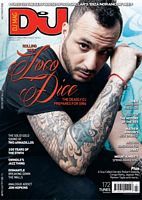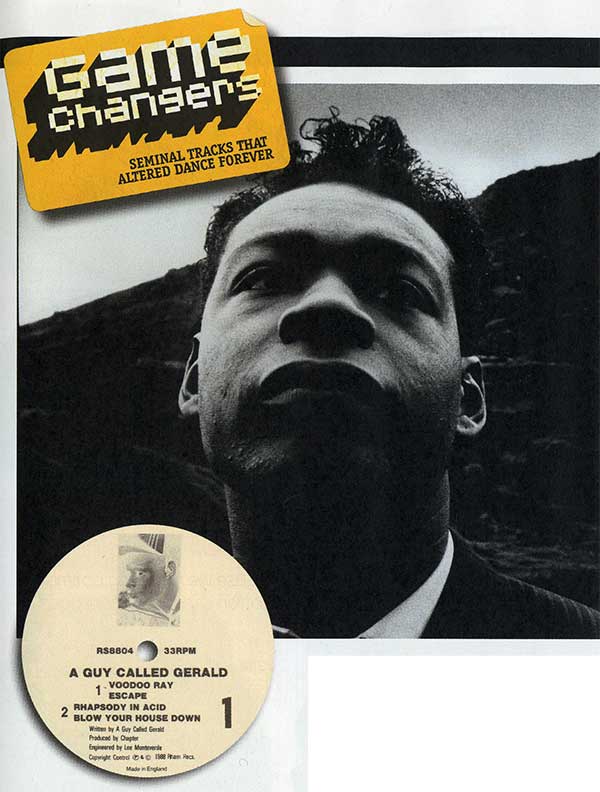| Game Changers: A Guy Called Gerald - Voodoo Ray | |
 |
DJ Magazine No. 523 July 2013 Page: 21 |
 A GUY CALLED 'Voodoo Ray' ITS one of the most iconic acid house records of all-time, but did you know that the amazing 'Voodoo Ray' by A byA Guy Called Gerald samples a couple of controversial British comedians? Gerald Simpson was originally in a hip-hop/electro kru in Manchester in the early '80s-the Scratch Beat Masters. It was a time when hip-hop was still the freshest thing on the block, and he immersed himself deeply in the culture. "I got into the cutting, scratch-mixing side of things," Gerald tells DJ Mag. After a while he started introducing a drum machine into the mix, and this was one of the key factors pushing him towards a recording studio world. Leaving the kru behind, he started acquiring more equipment by working as a carpet fitter (and later in McDonald's), and was soon jamming in his mum's attic with fellow electronic freaks Graham Massey and Martin Price. The three of them became 808 State. "There was no manuals, there was no internet - there was nothing," he says. "We were self-taught." "I managed to buy a TR-808 drum machine in about 1986, and didn't really look back," Gerald adds. "I boughta [Roland] SH-101, a Roland 303 and got hold of a little four-track and started building my own tunes, without the knowledge of what was going on in Chicago or Detroit. I was more inspired by what was coming out of NewYork-the electro-funk stuff." Piccadilly Radio in Manchester was playing early house and techno tracks from the US, and it started playing demos by local people too. "I used to send them some of the mixes that I did - and they'd play them," says Gerald. "The DJ [Stu Allen] called me up, he asked for more demos, and I got a little bit famous on the local station for my tracks." One day a guy from local electro-funk group Chapter & the Verse came round Gerald's house and told him there was a local label - Rham! Records - interested in releasing some of his tracks. They gave him some studio time in Moonraker Studios in Manchester in May 1988. "I went in and recorded five tracks, four of which ended upon an EP," Gerald recalls. "One of those was 'Voodoo Ray'." Gerald says that he isn't sure how long 'Voodoo Ray' took to make, as it was first of all jammed out in his bedroom. "In the studio to record, it probably took about half an hour," he says, "but actually writing it at home... I'm not sure." He'd taken a young woman called Nicola Collier, who lived on his estate, into the studio with him to record a soul track called 'Spend Some Time'. "I wanted to record as many tracks as possible while I was there - I'd never been in a recording studio before," he says. "The actual female vocal in 'Voodoo Ray' was Nicola's voice reversed, we reversed her vocal over the forward vocal - that's what created that hypnotic sound, two things passing each other." Gerald confirms that it was a Roland 303 doing the squelchy squiggly melody bits in the tune, and a Roland SH-101 making the clanging bass-block sounds that you can imagine a bow-legged, bug-eyed Bez from the Happy Mondays skanking to. "I used two [Roland] SH-101s, a 303 and an 808," he says. "They were the main things, and also - which was brand new at the time - an Akai S900 sampler, so it was a mixture of old and new." An avid collector of spoken word records, Gerald started chopping up a couple of words by Peter Cook, a '60s satirist who fashioned an enduring partnership with the comedian and pianist Dudley Moore. Gerald focused in on a part of Pete and Dud's 'Bo Dudley' sketch under their foul-mouthed aliases of Derek & Clive. "There wasn't enough memory in the sampler, so I ended up using "Voodoo Ray" instead of "Voodoo rage", which is what Peter Cook said," Gerald explains. "I didn't have enough space in the sampler to fit the whole thing in." Also sampling Dudley Moore shouting "Later!" in the sketch, a rambling pastiche breaking down a James Brown jam, Gerald then set about masking the samples and knitting everything together for 'Voodoo Ray's alien groove. "I really wanted to make something different, something sci-fi, something mysterious - that was the kind of music grew up listening to," he remembers. "I wasn't a big pop fan when I was a teenager, I was more into listening to Miles Davis or Chick Corea or obscure music." Gerald admits to DJ Mag that he did 'Voodoo Ray' with dancers in the seminal Manchester club the Hacienda in mind, and sure enough it quickly became a Hacienda anthem, before rapidly spreading throughout the UK's burgeoning acid house scene. The first 500 copies had sold out in a day, and after its ubiquity in the underground was cemented, it eventually crashed into the UK singles chart and became the biggest-selling independent single of 1989. Around the same time, 'Pacific State' by 808 State also became an underground anthem before charting too, but Gerald had left 808 State before the track's release and then claimed they had finished and released the track without his permission. He was soon signed by major label Sony, however, wowed by the success of 'Voodoo Ray' and the emerging dance market - but they tried to mould him into a pop artist. "The label tried me with writing teams and all sorts," he says. "But if I've already got my own sound, why change it? I was going into the studio with engineers who had no clue about the technique that I was using, and we just ended up fighting." Gerald says he missed much of the explosion of 'Voodoo Ray', and didn't even really hear it at a rave back then. "I was on tour most of the time, and when it was in the charts in the UK, I was in the US or Japan," he recalls. "I'd hear stories of how this music was starting to grow and become really big, trafficjams down the M25 and all that. In the US they were saying, 'What is this dance music?' and I was saying, 'Yeah, it's from Detroit'." He claims that he was in some sort of pocket- either at the eye of the hurricane [rave], or on the edge of something - and wasn't having a great time with Sony. He did manage to negotiate having his own imprint, Subscape, but Sony wouldn't Let him cut dubplates, they fell out, and he started his own independent label called Juicebox. He began producing jungle, making the pioneering '28 Gun Bad Boy' and 'Black Secret Technology' albums - but that's another story. Even though it received a Gold Disc, Gerald scarcely got any royalties from sales of 'Voodoo Ray' through Rham!, and although he licensed it to Warlock Records in the US for just two years, somebody is still pressing up copies on vinyl and selling them, more than 20 years on - with no monies coming to Gerald. "Throw the dog a bone or something?!" he says. "It's my intellectual property." He admits that his experience at the hands of dodgy label owners has soured 'Voodoo Ray' for him. "Totally. People want me to churn up old tunes, but I want to continue to make new tunes," the Berlin resident says. "That's my payment; that I can afford to make new tunes. If you get robbed, you feel violated. I'm a bit like that. But now I have a bank of new music, technology has moved in my favour." [Author: CARL LOBEN] |
|